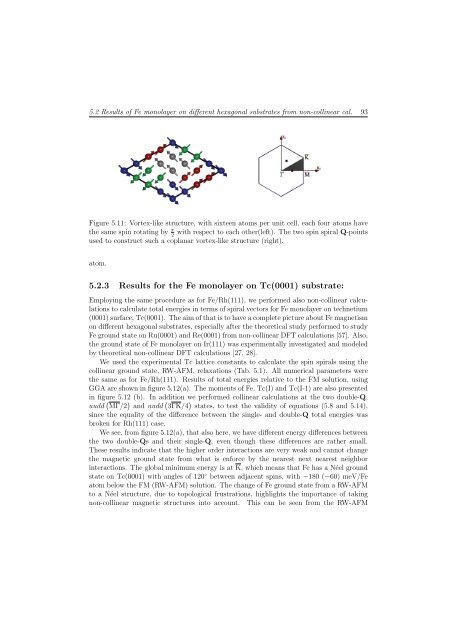Ab initio investigations of magnetic properties of ultrathin transition ...
Ab initio investigations of magnetic properties of ultrathin transition ...
Ab initio investigations of magnetic properties of ultrathin transition ...
Create successful ePaper yourself
Turn your PDF publications into a flip-book with our unique Google optimized e-Paper software.
5.2 Results <strong>of</strong> Fe monolayer on different hexagonal substrates from non-collinear cal. 93<br />
Figure 5.11: Vortex-like structure, with sixteen atoms per unit cell, each four atoms have<br />
the same spin rotating by π with respect to each other(left). The two spin spiral Q-points<br />
2<br />
used to construct such a coplanar vortex-like structure (right).<br />
atom.<br />
5.2.3 Results for the Fe monolayer on Tc(0001) substrate:<br />
Employing the same procedure as for Fe/Rh(111), we performed also non-collinear calculations<br />
to calculate total energies in terms <strong>of</strong> spiral vectors for Fe monolayer on technetium<br />
(0001) surface, Tc(0001). The aim <strong>of</strong> that is to have a complete picture about Fe magnetism<br />
on different hexagonal substrates, especially after the theoretical study performed to study<br />
Fe ground state on Ru(0001) and Re(0001) from non-collinear DFT calculations [57]. Also,<br />
the ground state <strong>of</strong> Fe monolayer on Ir(111) was experimentally investigated and modeled<br />
by theoretical non-collinear DFT calculations [27, 28].<br />
We used the experimental Tc lattice constants to calculate the spin spirals using the<br />
collinear ground state, RW-AFM, relaxations (Tab. 5.1). All numerical parameters were<br />
the same as for Fe/Rh(111). Results <strong>of</strong> total energies relative to the FM solution, using<br />
GGA are shown in figure 5.12(a). The moments <strong>of</strong> Fe, Tc(I) and Tc(I-1) are also presented<br />
in figure 5.12 (b). In addition we performed collinear calculations at the two double-Q,<br />
uudd � MΓ/2 � and uudd � 3ΓK/4 � states, to test the validity <strong>of</strong> equations (5.8 and 5.14),<br />
since the equality <strong>of</strong> the difference between the single- and double-Q total energies was<br />
broken for Rh(111) case.<br />
We see, from figure 5.12(a), that also here, we have different energy differences between<br />
the two double-Qs and their single-Q, even though these differences are rather small.<br />
These results indicate that the higher order interactions are very weak and cannot change<br />
the <strong>magnetic</strong> ground state from what is enforce by the nearest next nearest neighbor<br />
interactions. The global minimum energy is at K, which means that Fe has a Néel ground<br />
state on Tc(0001) with angles <strong>of</strong> 120 ◦ between adjacent spins, with −180 (−60) meV/Fe<br />
atom below the FM (RW-AFM) solution. The change <strong>of</strong> Fe ground state from a RW-AFM<br />
to a Néel structure, due to topological frustrations, highlights the importance <strong>of</strong> taking<br />
non-collinear <strong>magnetic</strong> structures into account. This can be seen from the RW-AFM

















